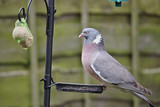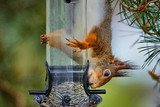How do birds fly? - The science explained
How do birds fly ? It’s one of the dearest miracles of the natural world, but it’s also one that we generally take for granted. Have you ever stopped to think: how do birds fly? Or, how do birds take off?
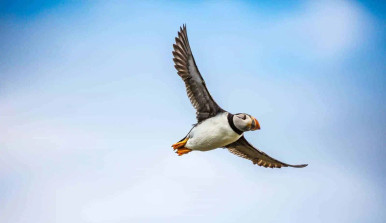
Whenever we’re on an aeroplane, we marvel at the mere idea that we’re flying. Why not attach that same curiosity to the natural world? In this article we’re going to cover the science behind how birds fly. Here goes!
Let’s start simple
Before we get into the scientific explanations for bird flight, we thought it best to give you a helpful analogy so that you get the basics. Have you ever put your hand outside the window while being a passenger in a driving car? You’ll have felt the air rush against your hand, almost swaying up and down with the force of the wind as it pushes against your flat palm. When you turn your hand sideways, you can slip your hand through the air easily - this is because the side of your hand has a smaller surface area than your palm, and it’s more streamlined - it’s flat, basically.
The side of your hand is flat like the wings of a bird. Thus, air flows easily around a bird’s wings in the direction the bird flies (just like your hand as it cuts through air). However, this is where things differ and something quite special happens.
As the air flows over the wings, the air flows faster over the top of the wing than the bottom because a bird’s wing is curved along the top. What this means is that there is more air on the bottom side because the air is moving slower than the top wing. So, when there is more air on the bottom part of the wing a pushing force is created which hits the wide, flat surface area that is the bottom part of the wing. It is this pushing force that lifts the bird. Ultimately, the wing slices into the air and, because the top part of the wing is curved, the bottom part of the wing gets pushed from below. Add the miracle of gravity and you have a flying bird!
So, how do birds fly? Let’s break it up
There are a few different aspects involved in bird flight, and each area is just as important. Here, we’re going to break down a few of the physical features of a bird and how they each play a part. We’re also going to look at the actual physics of bird flight.
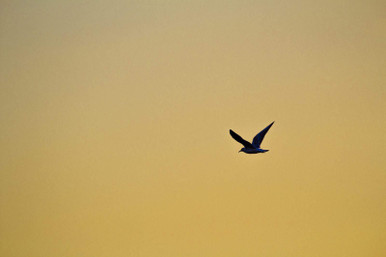
Physical features that help birds to fly
Lightweight feathers - A bird’s feathers are very lightweight, and smooth too. This means that they’re extra aerodynamic and are very receptive to the force of the wind.
Their beak is quite light, too - Rather than having heavy bone structures in the face, a bird’s beak is very light. This reduces the force of their weight, again making them very aerodynamic.
They have an enlarged breastbone for extra thrust - Called a sternum, birds have an enlarged breastbone that helps with the force of thrust and provides additional weight and surface area.
Birds also have very light bones - With extremely lightweight bone structures (they’re essentially hollowed out and supported by tiny cross bones) a bird has reduced weight which makes them even more aerodynamic.
They have a streamlined body - there are very few birds whose bodies are not built for streamlined aerial pursuits. Their bodies are naturally suited to the sky, as their streamlined to reduce the force of drag.
How do birds ‘glide’
You may have seen birds glide through the air like it’s the most effortless thing in the world. Well, it kind of is! Birds don’t do any work when they glide because it’s all down to physics. When gliding, a bird will hold its wings out to the side of its body without actually flapping. And, as the wings move through the air, they’re held at a slight angle which then deflects the air downwards and causes a reaction in the opposite direction (we call this lift).
At the same time, there is drag affecting the bird’s body. To maintain speed (and to keep itself up in the air), a bird must tilt forward and go into a slight dive so that it can keep going.
How do birds ‘soar’
Similar to how they glide, soaring involves the bird flying in a rising air current (which is basically where strong winds propel the bird on). Because the air is rising, the bird can maintain its height.
Perhaps most importantly, how do birds ‘flap’
Simply put, it’s an up-and-down motion which propels them onward. A bird’s entire wingspan has to be at the right angle of attack which means that the wings have to twist with each downward stroke depending on which direction the bird is travelling.
So, how do birds take off?
This is perhaps the simplest part of all. Called ‘thrust’, birds take off using a similar maneuver used in the sky. Birds take off by using their strong (albeit small) muscles and flapping their wings. When taking off, they often start from a running position which gives them additional thrust.
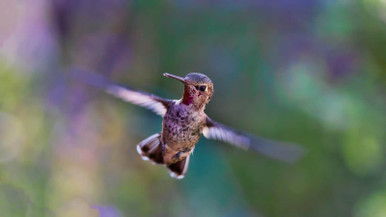
There are some exceptions…
The natural world is not without its mysteries. There are plenty of birds out there who do things a little differently, and here are a few examples.
- There are small birds that hover. Smaller birds (especially kestrels and sparrows for a limited time) can hover because their wings are small. To hover, they simply flap their wings to generate lift but do not expend energy to pass through the air. You can compare it to us treading water.
- Many smaller birds incorporate their tails into flight, as it works rather like the fin on a small aircraft to generate air resistance and drag so that it can easily slow down.
- Birds like gannets are more streamlined than most others so that they can dive, at high speed, into the water to catch fish.
What will you feed your birds?
Now that you understand the miracles of bird flight, it’s time to learn what exactly you need to feed the birds in your area. You’ll want to visit our blog section which is packed full of bird-related insights. Next, take a look at our range of peanuts for birds. You’ll soon have plenty of birds swooping through your neighbourhood!
Explore Popular Articles
-
8 Easy Ways to Attract Woodpeckers to Your Garden
8th Apr 2024Woodpeckers are among the most interesting birds known for their drumming sound and bright colours.
-
How to Protect Your Bird Feeders from Pigeons ?
28th Mar 2024You must have noticed damaged feeding ports, hanging mechanisms, perches, lids and bottoms. Who coul
-
5 Foolproof Ways to Rat-Proof Your Bird Feeder
18th Mar 2024Building a bird-friendly environment is a delightful endeavour, but it involves the responsibility o



